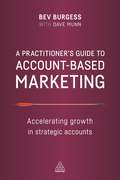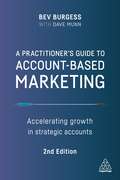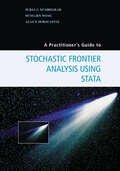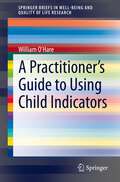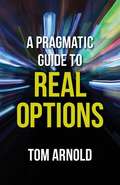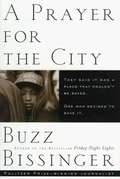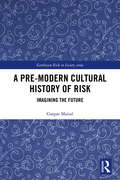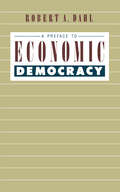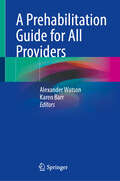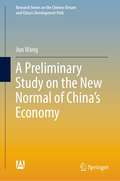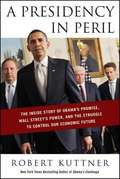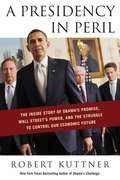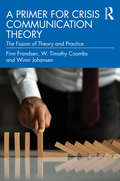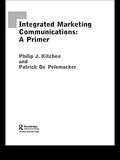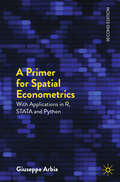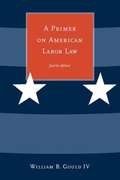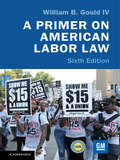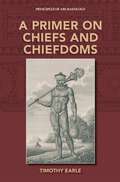- Table View
- List View
A Practitioner's Guide to Account-Based Marketing: Accelerating Growth in Strategic Accounts
by Bev Burgess Dave MunnAccount-based marketing, also known as client-centric marketing, is in the process of transforming modern marketing practice. It involves taking a strategic approach to business to business marketing, whereby important individual accounts are treated as markets in their own right. After all, many of the world's leading companies have annual revenues the size of some countries' GDP, so for the businesses that provide services and solutions to these companies, such key accounts truly do represent a global market. A Practitioner's Guide to Account-Based Marketing explores the development of account-based marketing (ABM) as a business practice, and outlines a clear, step-by-step process for readers who wish to set up an ABM programme to accelerate growth. Rich with fascinating case studies and personal stories, A Practitioner's Guide to Account-Based Marketing offers readers privileged access to lessons learned by pioneering companies in the field, including BT, Fujitsu, IBM, Juniper Networks, Microsoft, SAP, and many more. The text is fully endorsed by the Information Technology Services Marketing Association (ITSMA), who run the only formally recognized qualification in the sector: the Account-Based Marketing Certification Programme. Meticulously researched and highly practical, A Practitioner's Guide to Account-Based Marketing will help all marketers strengthen relationships, build reputation, and increase revenues in their most important accounts.
A Practitioner's Guide to Account-Based Marketing: Accelerating Growth in Strategic Accounts
by Bev Burgess Dave MunnAs some of today's major and complex companies are worth more than the GDPs of some countries, traditional marketing approaches, such as glossy corporate campaigns, will have limited returns. Account-based marketing, also known as client-centric marketing, treats important individual accounts as markets in their own right, to help strengthen relationships, build reputation, and increase revenues in important accounts.A Practitioner's Guide to Account-Based Marketing outlines a clear, step-by-step process for readers to harness ABM tools and techniques and set up ABM programmes. Featuring insights from practising professionals and case studies from organizations including Microsoft, Accenture, O2 and Fujitsu, it also contains guidance on developing the competencies needed for account-based marketing and managing your ABM career. This updated second edition contains further discussion on how ABM initiatives can go from a pilot to being embedded in a business, new material on quantified value propositions and updated wider research. Meticulously researched and highly practical, A Practitioner's Guide to Account-Based Marketing will help all marketers to deliver successful B2B marketing.
A Practitioner's Guide to Asset Allocation
by Harry M. Markowitz Mark P. Kritzman David Turkington William KinlawThe authors' goal in writing this book is twofold: to describe several important innovations that address key challenges to asset allocation and to dispel certain fallacies about asset allocation. Section I covers the fundamentals of asset allocation, section II presents certain fallacies about asset allocation which the authors attempt to dispel either by logic or with evidence, section III discusses recent innovations, and section IV provides supplementary material.
A Practitioner's Guide to Stochastic Frontier Analysis Using Stata
by Subal C. Kumbhakar Hung-Jen Wang Alan P. HorncastleStochastic Frontier Analysis Using Stata provides practitioners in academia and industry with a step-by-step guide on how to conduct efficiency analysis using the stochastic frontier approach. The authors explain in detail how to estimate production, cost, and profit efficiency and introduce the basic theory of each model in an accessible way, using empirical examples that demonstrate the interpretation and application of models. This book also provides computer code, allowing users to apply the models in their own work, and incorporates the most recent stochastic frontier models developed in academic literature. Such recent developments include models of heteroscedasticity and exogenous determinants of inefficiency, scaling models, panel models with time-varying inefficiency, growth models, and panel models that separate firm effects and persistent and transient inefficiency. Immensely helpful to applied researchers, this book bridges the chasm between theory and practice, expanding the range of applications in which production frontier analysis may be implemented.
A Practitioner’s Guide to Using Child Indicators (SpringerBriefs in Well-Being and Quality of Life Research)
by William O'HareThis book focuses on projects using child indicators outside of a research context and provides a user-friendly set of materials to help professionals or organizations start and sustain high-quality child indicator projects. The book is based on the fundamental idea that better data leads to better decisions regarding programs for children. The number of people with experience and expertise in developing child indicator projects is limited in many countries. This initiative provides critical information on the topic in a cost-effective manner, and thereby fills an important niche regarding the use of child indicators. To the extent that it promotes more and better child indicator projects, the book leads to more attention for children and better decision-making regarding public support for children. It is also likely to increase the number of such projects that exist and to improve the quality of such projects. This easy-to-use and practical guide is for all professionals and organizations working with child indicators data.
A Pragmatic Guide To Real Options
by Tom ArnoldAimed at practitioners with no prior expertise in the subject, this book helps readers build basic real options models to aid in decision-making. Providing a pragmatic and informative approach, the authors introduce basic probability theories, before putting these theories into a real-world context.
A Prayer for the City: The True Story of a Mayor and Five Heroes in a Race Against Time
by Buzz BissingerA Prayer for the City is Pulitzer Prize-winning journalist Buzz Bissinger's true epic of Philadelphia mayor Ed Rendell, an utterly unique, unorthodox, and idiosyncratic leader who will do anything to save his city: take unions head on, personally lobby President Clinton to save 10,000 defense jobs, or wrestle Smiley the Pig on Hot Dog Day--all the while bearing in mind the eternal fickleness of constituents whose favor may hinge on a missed garbage pick-up or an overzealous meter maid. It is also the story of citizens in crisis: a woman fighting ceaselessly to give her great-grandchildren a better life, a father of six who may lose his job at the Navy Shipyard, and a policy analyst whose experiences as a crime victim tempt her to abandon her job and ideals. Heart-wrenching and hilarious, alive with detail and insight, A Prayer for the City describes a city on its knees and the rare combination of political courage and optimism that may be the only hope for America's urban centers.
A Pre-Modern Cultural History of Risk: Imagining the Future (Earthscan Risk in Society)
by Gaspar MairalThis book answers the need for a contextual, long-term and interpretative analysis of risk from original sources. Risk has historically been a way of imagining what could happen in the future based on expert theories and predictions. This book explores this notion of "managing the future" by tracing the conceptual development of risk from its origin in Islamic Koranic theology. It follows its long voyage from mercantile law and navigation in Medieval Mediterranean and the Atlantic Ocean, to Columbus' arrival to the Indies and the Spanish exploration and colonization in the Americas. It considers the mathematical invention of probability in games of chance, the birth of journalism in Britain with Defoe’s Journal of the Plague Year, the earthquake of Lisbon in 1755 and the subsequent controversy between apocalyptic believers and enlightened philosophers. Tracking the growth and evolution of risk as a concept across various historical periods and events, Mairal highlights four key features of risk - time, knowledge, relationship and probability - and argues that risk is not based on perception as it is generally presented, but rather on knowledge accrued and developed over a vast historical time frame. A Pre-Modern Cultural History of Risk will be of great interest to students and scholars of risk management.
A Precarious Game: The Illusion of Dream Jobs in the Video Game Industry
by Ergin BulutA Precarious Game is an ethnographic examination of video game production. The developers that Ergin Bulut researched for almost three years in a medium-sized studio in the U.S. loved making video games that millions play. Only some, however, can enjoy this dream job, which can be precarious and alienating for many others. That is, the passion of a predominantly white-male labor force relies on material inequalities involving the sacrificial labor of their families, unacknowledged work of precarious testers, and thousands of racialized and gendered workers in the Global South. A Precarious Game explores the politics of doing what one loves. In the context of work, passion and love imply freedom, participation, and choice, but in fact they accelerate self-exploitation and can impose emotional toxicity on other workers by forcing them to work endless hours. Bulut argues that such ludic discourses in the game industry disguise the racialized and gendered inequalities on which a profitable transnational industry thrives. Within capitalism, work is not just an economic matter, and the political nature of employment and love can still be undemocratic even when based on mutual consent. As Bulut demonstrates, rather than considering work simply as a matter of economics based on trade-offs in the workplace, we should consider the question of work and love as one of democracy rooted in politics.
A Preface To Marketing Management (Fifteenth Edition)
by James H. Donnelly J. Paul PeterWe are proud to introduce the fifteenth edition knowing that our book and its eight foreign translations have been used around the world whenever courses require a concise overview of the critical aspects of marketing management. <P><P> In this edition, we have maintained the format and features of the book that make it a teachable text. We have also updated existing content and added new content to better reflect the changes in marketing management and its environment. We present quality content and examples and avoid excessive verbiage, pictures, and descriptions.
A Preface to Economic Democracy (Quantum Books #28)
by Robert A. DahlTocqueville pessimistically predicted that liberty and equality would be incompatible ideas. Robert Dahl, author of the classic A Preface to Democratic Theory, explores this alleged conflict, particularly in modern American society where differences in ownership and control of corporate enterprises create inequalities in resources among Americans that in turn generate inequality among them as citizens.Arguing that Americans have misconceived the relation between democracy, private property, and the economic order, the author contends that we can achieve a society of real democracy and political equality without sacrificing liberty by extending democratic principles into the economic order. Although enterprise control by workers violates many conventional political and ideological assumptions of corporate capitalism as well as of state socialism. Dahl presents an empirically informed and philosophically acute defense of "workplace democracy." He argues, in the light of experiences here and abroad, that an economic system of worker-owned and worker-controlled enterprises could provide a much better foundation for democracy, political equality, and liberty than does our present system of corporate capitalism.
A Prehabilitation Guide for All Providers
by Alexander Watson Karen BarrAs more medical professionals recognize the intuitive benefits of prehabilitation, there is a need to pull best practices that exist across the literature and set a multimodal standard of care. This innovative book fills this need and provides a (should we say "the most"?) comprehensive guide to prehabilitation. Authored by experts in each area of surgery, perioperative care, and rehabilitation medicine, the book's chapters introduce the concept of prehabilitation and describe the current medical optimization strategies, unique patient considerations, and the continuum of care for each procedural population. This text provides data from the existing literature on typical programs' impact on outcomes and complication rates, and it proposes detailed treatment plans for providers to incorporate into practice. A Prehabilitation Guide for All Providers explores actionable insights for a broad audience, including primary care physicians, surgeons, anesthesiologists, and physical medicine and rehabilitation specialists, as well as non-clinical professionals in policy-driving positions such as hospital administration or governmental organizations.
A Preliminary Study on the New Normal of China's Economy (Research Series on the Chinese Dream and China’s Development Path)
by Jun WangThis book shows a panorama of sustainable development practices covering 70 major cities. This book has created the analysis framework of the “New Normal” of China’s economy, demonstrated the features and connotation of the "New Normal", carried out in-depth analysis and systematic study on the connotation and extension of the “New Normal” of China’s economy from ten aspects including growth shift, structural upgrading, innovation drive, regional synergy, moderate inflation, reform bonus, opening-up forced, risk exposure, sustainable development and macro-control in details and proposed targeted policy suggestions with practical application value that adapt to the new normal of China's economy and ensure the sustained, steady and healthy operation of the macro-economy.
A Presidency in Peril
by Robert KuttnerAs with many progressives who had pinned their hopes on the promise of Barack Obama, Kuttner (co-editor of The American Prospect magazine) has become disappointed with President Obama's failure to deliver transformational change in the realm of US economic policy. He delivers a work of reportage, analysis, and critique that seeks to understand the reasons for Obama's basic acquiescence to the priorities of Wall Street over those of Main Street and his failure to push for strong financial regulation in the face of economic crisis. Although he is critical of Obama's economic performance in the first two years, he holds out hope that the President may yet salvage his legacy and offers advice on how Obama could go about redeeming his presidency. Annotation ©2010 Book News, Inc. , Portland, OR (booknews. com)
A Presidency in Peril: The Inside Story of Obama's Promise, Wall Street's Power, and the Struggle to Control Our Economic Future
by Robert KuttnerAs with many progressives who had pinned their hopes on the promise of Barack Obama, Kuttner (co-editor of The American Prospect magazine) has become disappointed with President Obama's failure to deliver transformational change in the realm of US economic policy. He delivers a work of reportage, analysis, and critique that seeks to understand the reasons for Obama's basic acquiescence to the priorities of Wall Street over those of Main Street and his failure to push for strong financial regulation in the face of economic crisis. Although he is critical of Obama's economic performance in the first two years, he holds out hope that the President may yet salvage his legacy and offers advice on how Obama could go about redeeming his presidency. Annotation ©2010 Book News, Inc. , Portland, OR (booknews. com)
A Primer for Crisis Communication Theory: The Fusion of Theory and Practice
by W. Timothy Coombs Finn Frandsen Winni JohansenGuided by a belief that good crisis communication theory should inform and improve practice, this book makes a wide range of theories utilized in crisis communication accessible to researchers, students, and practitioners.The book begins with an extended discussion of applied theory, including the theory building process, to help the reader appreciate how theory can connect to the practice of crisis communication. This discussion is followed by chapters each explaining a theory and using an evidence-based approach to explore how that theory illuminates and applies to crisis communication practice. The array of theories includes those that are descriptive, prescriptive, and critical and cover the areas of public crises, political crises, and corporate crises.This book is essential reading for advanced students of public relations and strategic communication and researchers in crisis and risk communication, with practical insights suitable for interested professionals.
A Primer for Integrated Marketing Communications
by Patrick De Pelsmacker Philip KitchenThis textbook is the first introductory primer on integrated marketing communications. It combines theory and practice to show students of marketing how different aspects of integrated marketing communications (IMC) work together. Setting the scene in which IMC has emerged, the authors explain each component of the promotional mix and go on to explain the process of functional integration. The text includes key case studies on companies, including Proctor and Gamble, NSPCC and Ardi, illustrating the practical side of IMC in addition to an introduction to the main theories at work. Including an additional Study Guide at the back, this book will be a valuable resource for students of marketing and marketing communications.
A Primer for Spatial Econometrics: With Applications In R (Palgrave Texts in Econometrics)
by Giuseppe ArbiaThis book aims at meeting the growing demand in the field by introducing the basic spatial econometrics methodologies to a wide variety of researchers. It provides a practical guide that illustrates the potential of spatial econometric modelling, discusses problems and solutions and interprets empirical results.
A Primer for Spatial Econometrics: With Applications in R, STATA and Python (Palgrave Texts in Econometrics)
by Giuseppe ArbiaThis textbook offers a practical and engaging introduction to spatial econometric modelling, detailing the key models, methodologies and tools required to successfully apply a spatial approach. The second edition contains new methodological developments, new references and new software routines in R that have emerged since the first edition published in 2014. It also extends practical applications with the use of the software STATA and of the programming language Python. The first software is used increasingly by many economists, applied econometricians and social scientists while the software Python is becoming the elective choice in many scientific applications. With new statistical appendices in R, STATA and Python, as well as worked examples, learning questions, exercises and technical definitions, this is a significantly expanded second edition that will be a valuable resource for advanced students of econometrics.
A Primer of National Finance (Routledge Revivals)
by Henry HiggsOriginally published in 1919, A primer of National Finance discusses elements of financial principles with reference to facts and figures of British National Finance, Britain’s financial position and general outline of where finances stood at the time of publication. Higgs aims to explain essential information about the political economy in a simple and concise way to reach a wider audience on issues related to wealth and production. This title will be of interest to students of Economics and Political History.
A Primer on American Labor Law
by William B. Gould IVSince its publication more than a decade ago, A Primer on American Labor Law has served as an easily accessible guide to the development, principles, and characteristics of American labor law. The third edition incorporates a number of significant developments that have taken place since 1986. These include new precedent under the Railway Labor Act (covering both railroads and airlines), the expansion of wrongful discharge litigation (which has become increasingly important as the unorganized sector of the work force continues to expand), new forms of protection against discrimination afforded by the Americans with Disabilities Act of 1990 and the Civil Rights Act of 1991, the consent decree between the U. S. Department of justice and the International Brotherhood of Teamsters, and the continued success of unions representing professional athletes. William B. Gould IV is Charles A. Beardsley Professor of Law at Stanford Law School. An impartial arbitrator of labor disputes since 1965, he is a member of the Clinton Administration's Committee on the Future of Worker-Management Relations. He is the author of Agenda for Reform: The Future of Employment Relationships and the Law.
A Primer on American Labor Law (4th edition)
by William B. GouldThis book is an accessible guide written for non specialists' labor and management representatives, students, general practice lawyers, as well as trade unionists, government officials, and academics from other countries.
A Primer on American Labor Law (The\mit Press Ser.)
by William B. Gould IVThere are many new realities confronting labor in the United States. Technology is redefining traditional employment, and globalization continues moving manufacturing as well as service jobs to lower-cost jurisdictions. This timely sixth edition discusses the recent political developments that impact American labor, as well as new court cases and the social and economic issues that American workers are confronting. For union and employer representatives and labor lawyers, alike this volume not only describes the labor law system briefly and clearly, but also attempts to further an understanding among workers, unions, and businesses in order to promote an improved working environment. Professor William B. Gould, IV brings to this work more than a half-century of experience as a practicing labor lawyer and academic, as well as practical exposure to the relationship between administrative agencies and the public.
A Primer on Austrian Macroeconomics: Austrian Capital Theory for Macroeconomic Research and Teaching (Palgrave Studies in Austrian Economics)
by Antony P. MuellerThis book offers an accessible framework for macroeconomic modelling rooted in the capital theory of Austrian Economics. By distinguishing between the goods and monetary sides of the economy and exploring their interaction, the book provides a comprehensive macroeconomic model that integrates time preference and interest rates. It examines how monetary and fiscal policies can produce business cycles and how these cycles are influenced by central bank liquidity and financial market behaviour. Additionally, the book discusses the ways in which monetary and fiscal policies can prolong and intensify economic stagnation. Through its clear exposition, this book deepens the understanding of the conditions that determine the unsustainability of credit-driven economic expansions. It is essential reading for students and researchers in political economy, macroeconomics, monetary economics, and those interested in advancing Austrian Economics.
A Primer on Chiefs and Chiefdoms (Principles of Archaeology)
by Timothy EarleChiefs are political operatives who hold titles of leadership over groups larger than intimate kin-based communities. Although they rule with the consent of their group, they are all about building personal power and respect. Many scholars have viewed chiefs as problem solvers--defending groups against aggressors, resolving disputes, providing support under hardship, organizing labor for community projects, and redistributing goods among those in need. Chiefs do these things, but much of what chiefs do is accumulate benefits for themselves, staying in power and legitimizing control. Anthropological archaeology is well suited to pursue the study of chiefs, their leadership institutions (chiefdoms), and long-term historical processes. The author argues that studying chiefdoms is essential to understanding the role of elemental powers in social evolution. As an illustration, he studies chiefs and their power strategies in historically independent prehistoric and traditional societies and discusses how they continue to exist as powerful actors within modern states.
